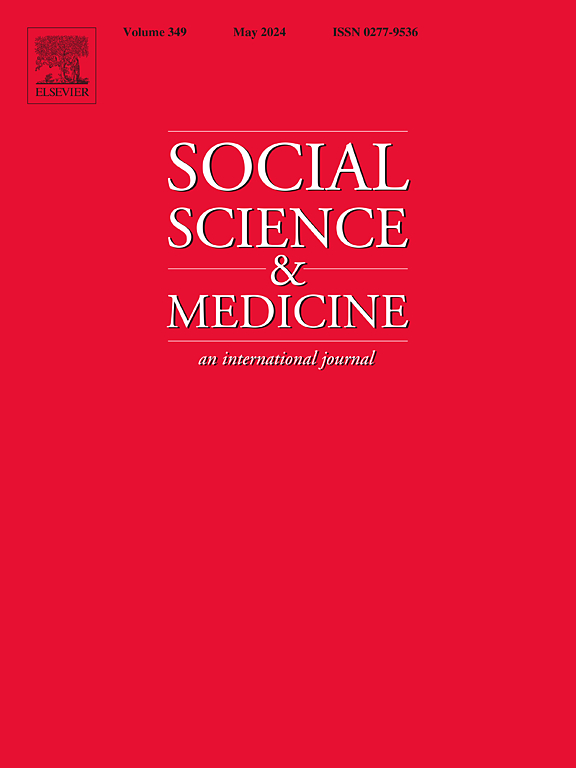Socioeconomic inequalities in developing cardiometabolic diseases and transition to depression: A trajectory analysis of large-scale population-based study
IF 5
2区 医学
Q1 PUBLIC, ENVIRONMENTAL & OCCUPATIONAL HEALTH
引用次数: 0
Abstract
Existing evidence demonstrates a high risk of developing depression in patients with cardiometabolic diseases (CMDs). However, it remains unclear whether socioeconomic inequality exacerbates the progression. We aimed to quantify the role of socioeconomic status (SES) in the progression from healthy to CMDs and their transitions to depression. A total of 376 610 participants (age 37–73 years) free from CMDs of interest, including type 2 diabetes (T2D), coronary heart disease (CHD) and stroke, from the ongoing UK Biobank study between 2006 and 2010 were included at baseline. Potential various SES groups were derived from latent class analysis using family income level, employment status and education attainment. In latent class analysis, three distinctive levels of SES (low, medium, and high) were identified. During the 15-year follow-up, we found significant associations were found between low SES and different progression stages of CMDs. In multivariate models, the hazard ratios (95 % confidence intervals) for low SES vs. high SES were 1.62 (1.53–1.71), 1.23 (1.17–1.29) and 1.25 (1.13–1.38) for transitions from healthy to T2D, CHD and stroke, and 2.17 (2.03–2.30), 1.63 (1.30–2.03), 1.62 (1.30–2.03), 1.70 (1.11–2.60) for risk of transition to depression from healthy, T2D, CHD and stroke, respectively. Socioeconomic inequalities were associated with almost all transition stages from healthy to CMDs, subsequently to depression, with different magnitude of associations. These findings support the need for targeted screening programs for depression in CMD patients, and policy interventions addressing socioeconomic inequalities through improved access to healthcare, education, and economic opportunities for disadvantaged populations.
社会经济不平等在发生心脏代谢疾病和向抑郁症转变中的作用:一项大规模人群研究的轨迹分析
现有证据表明,患有心脏代谢疾病(cmd)的患者患抑郁症的风险很高。然而,目前尚不清楚社会经济不平等是否加剧了这一进程。我们旨在量化社会经济地位(SES)在从健康到慢性疾病及其向抑郁症转变过程中的作用。从2006年至2010年英国生物银行研究中,共有376 610名参与者(37-73岁)没有相关的CMDs,包括2型糖尿病(T2D)、冠心病(CHD)和中风。利用家庭收入水平、就业状况和受教育程度进行潜在阶层分析,得出潜在的不同社会经济地位群体。在潜在分类分析中,确定了三个不同的SES水平(低、中、高)。在15年的随访中,我们发现低SES与CMDs不同进展阶段之间存在显著关联。在多变量模型中,低经济地位与高经济地位的人群从健康状态过渡到T2D、冠心病和卒中的风险比(95%可信区间)分别为1.62(1.53-1.71)、1.23(1.17-1.29)和1.25(1.13-1.38),从健康状态、T2D、冠心病和卒中过渡到抑郁的风险比分别为2.17(2.03-2.30)、1.63(1.30-2.03)、1.62(1.30-2.03)、1.70(1.11-2.60)。社会经济不平等与从健康到慢性疾病,继而到抑郁的几乎所有过渡阶段都有关联,关联程度不同。这些发现支持有针对性地筛查CMD患者抑郁症项目的必要性,以及通过改善弱势群体获得医疗保健、教育和经济机会来解决社会经济不平等问题的政策干预。
本文章由计算机程序翻译,如有差异,请以英文原文为准。
求助全文
约1分钟内获得全文
求助全文
来源期刊

Social Science & Medicine
PUBLIC, ENVIRONMENTAL & OCCUPATIONAL HEALTH-
CiteScore
9.10
自引率
5.60%
发文量
762
审稿时长
38 days
期刊介绍:
Social Science & Medicine provides an international and interdisciplinary forum for the dissemination of social science research on health. We publish original research articles (both empirical and theoretical), reviews, position papers and commentaries on health issues, to inform current research, policy and practice in all areas of common interest to social scientists, health practitioners, and policy makers. The journal publishes material relevant to any aspect of health from a wide range of social science disciplines (anthropology, economics, epidemiology, geography, policy, psychology, and sociology), and material relevant to the social sciences from any of the professions concerned with physical and mental health, health care, clinical practice, and health policy and organization. We encourage material which is of general interest to an international readership.
 求助内容:
求助内容: 应助结果提醒方式:
应助结果提醒方式:


